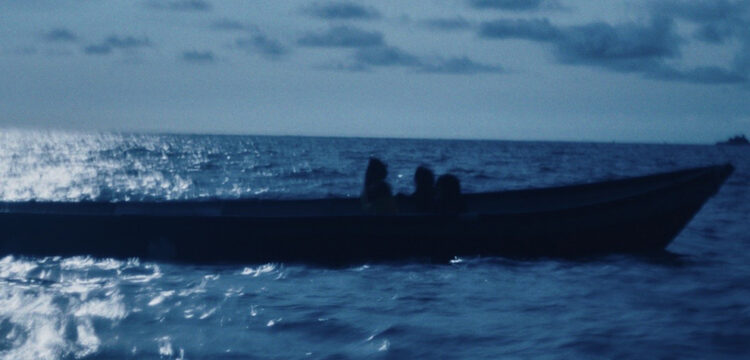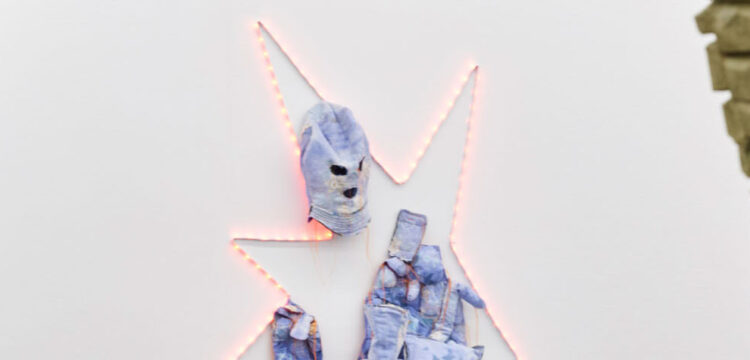Morphing Practices
On fluidity, hydrofeminism and isomorphous drips
Reflecting on Maya Hottarek and Julian Zehnder’s current exhibition at KRONE COURONNE in Biel/Bienne (CH), Elise Lammer sits down with the artists to discuss collaborative practice as a means of resistance to power conventions in the art world, as well as the notion of fluidity in the context of gender and care work.
Elise Lammer: Most of the works on display are signed with both your names, suggesting, within the locus and conventions of the exhibition’s press release, a collaboration that encompasses the entire production of the works. Can you describe the collaborative process, its timeline, and so on?
Maya Hottarek: I was working in Biel and Basel, while Julian was working from Graz and Zurich. It started digitally, via video conversations. Two remote ideas came together within a process of negotiation in which we decided what was possible. Then, each would do their part. The week we put the show together in Biel allowed us to be in the same space and to find out if everything had turned out as we had imagined. Trust was key in the process, since we didn’t meet in person very often.
The idea for Zen Spice Mandala for example came from Julian. In previous collaborations I would make a sculpture first and he would then create a specific sound for it. But for isomorphous drip the idea was to “morph” our practices, with a common conceptual material as source for both sound and sculptures.
Julian Zehnder: Zen Spice Mandala was created, somehow, as a kinetic and interactive work. When rotating, the ceramic items attached to the rope bang together softly. The rotation isn’t really fast, so the sound is almost inaudible. But the work was designed to be occasionally “activated”. For example, as a special event, we are inviting the artist and drummer Julian Sartorius to play with the works.
MH: The powder used in Zen Spice Mandala is engobe (a textural powder usually applied to ceramic before the first firing). I also used some of it in free transmission, a wall painting also featured in the exhibition. It’s a material that not only accompanies all the ceramic elements of the exhibition, but also acts as a binding material that connects all the works.
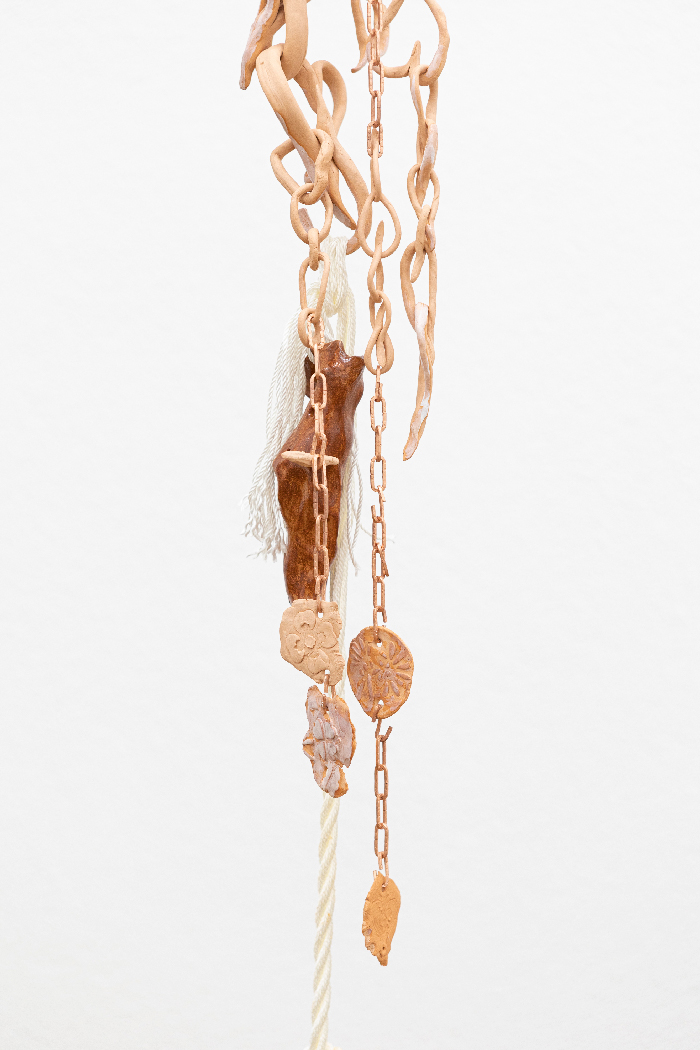
EL: Does the title of the exhibition [isomorphous drip] refer to fluidity? Fluid as opposed to fixed within the definition of gender, but also from a scientific point of view, in regard to a state of matter that flows. How are such definitions relevant within your artistic approaches? Understood as a philosophical concept within contemporary critical discourse, fluidity has lately become an ambiguous, over-hyped term, used within different fields (art, gender studies, politics, etc.) often without being contextualised.
JZ: The term is used in biology to describe how different organisms can co-exist and how a specific environment can trigger specific reactions. Our collaboration took inspiration from that phenomenon, while trying to go a step further than simply layering media, by really merging our practices from the onset. Isomorphous reflects how the sound and the sculptures were created, and also how they interact with the viewers.
MH: Since I started working as an artist I used water and fire as references, and although it wasn’t clear in the beginning why those two opposed elements were so important, at some point I started working with “real” water, making fountains and different types of containers and vessels. When Astrida Neimani’s Hydrofeminism: Or, On Becoming a Body of Water was published, I was so happy to have a theoretical text that echoed my work and validated what I was doing. Although I feel really connected to Neimani’s ideas, my work is not only based on the notion of hydrofeminism. Every time there is a hype, when everybody is going in the same direction, it makes it harder to make a point. The concept of fluidity still makes a lot of sense in the context of this exhibition. The title and concept should offer the viewer a possibility to “morph” with the works, and hopefully to forget what they did earlier that day and to simply be there. Become fluid within the show.
EL: So morphing doesn’t only apply to the nature/process of the collaboration but also to its potential effect on the viewer?
MH: Indeed. As artists we dedicate so much time to our own work, often for it to be only experienced for very short periods of time by others. As a medium, sound can provide a great tool to create longer time frames. Isomorphous drip was conceived as an invitation to spend more time with the works.
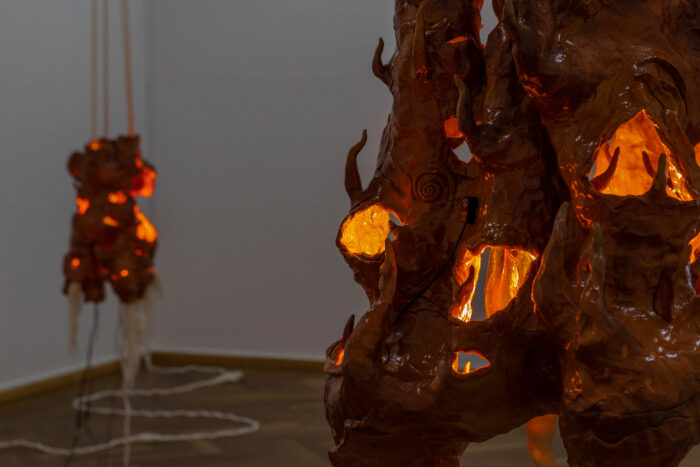
EL: Did you think of a specific timeline, how long is the full cycle of the exhibition?
JZ: Sound is of course time-based, but we really tried to avoid defining a timeline. Fluidity may also apply to the lack of cycle here, by means of an exhibition without repetitions. For example, in the past I’ve composed works with defined lengths that could be occasionally looped. But an algorithm defines the sound concept of isomorphous drip. My role as a composer was therefore to provide a frame for “what” could happen, but I didn’t define the “how”. As Maya mentioned, when spending longer periods of time within the soundscape, you get to realise that there are many different things happening. A bit like a stream of running water, which may sound homogenous, but is in fact always changing when you start to pay attention.
MH: You have to be patient when listening. I think it’s a very slow show, it’s not entertaining. You really have to hang around and spend some time there and listen.
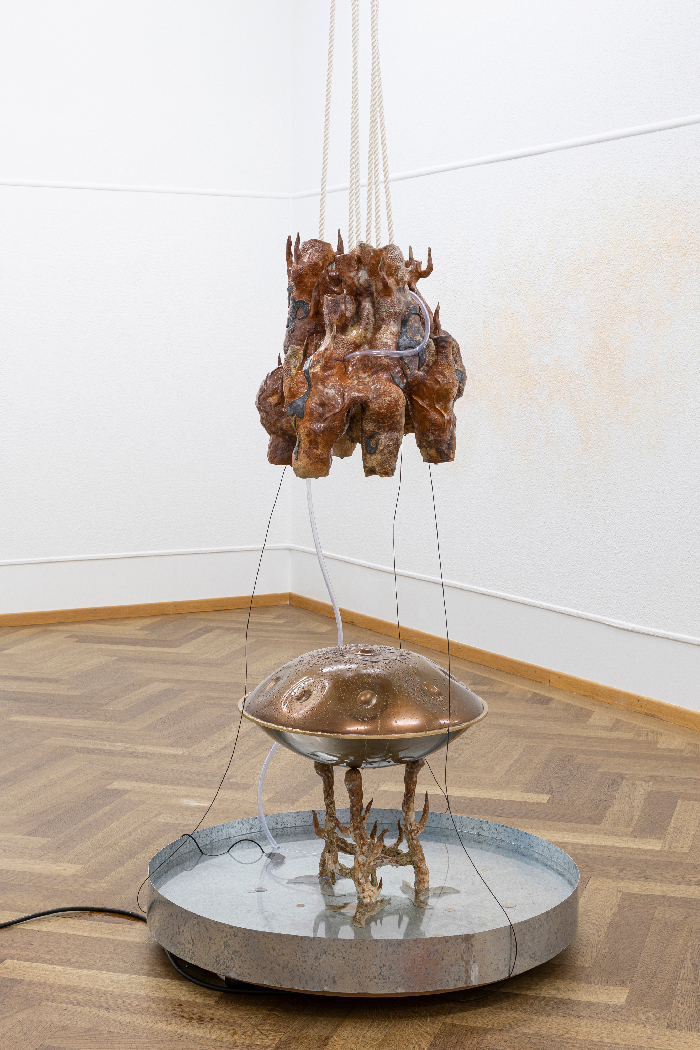
EL: How is gender approached within the collaboration? There is a reference to a cyborg as an entity resulting from the merging of your practices. Harraway’s cyborg (in Donna Harraway’s Cyborg Manifesto, 1983) became cyberfeminists’ ideal citizen for a post-patriarchal world. I can see this within Maya’s post-apocalyptic, neo-futuristic aesthetic, and how she uses craft within sci-fi-rooted narratives, allowing many potential (revolutionary) worlds to emerge. But the way labour was organized in the creation of the works could be interpreted as reinforcing some sexist stereotypes…
MH: Right. The woman is working with ceramics and the man with machines… I can see how traditionally ceramics have been connected to female work and robotics to male fields of expertise. However, this didn’t matter to us, and it isn’t relevant to this project. That said, the question of gender is addressed elsewhere within the show. The installation soft radiations, originally titled love lights, carries, I think, a strong transformative power. Shaped after a chest cavity, where the heart is located, it’s hanging from the ceiling and contains lights that glow onto the viewer’s face, when they get near enough. This gesture emulates how love should or could be. Symbolically, it’s a work that aims to dissolve gender issues through its radiation; that invites one to open up their heart. But I would never describe it only through the prism of gender.
JZ: As a composer, in my daily practice I’m a witness of an environment mostly under the control of white men; most of the composers I’ve studied are still white men and that’s very problematic. During the collaboration, our assigned genders were never a theme, but the works do reflect such concerns on a different level. Generic drums is an installation made of transformed snare drums. Drums are often connected to stereotypes of masculinity; from muscly pop stars to army men marching to war. In this installation the instruments are playing by themselves by means of a pre-programmed algorithmic technology that allowed me to present an installation where the human performer was entirely removed. This genderless algorithm can decide on their own and continues to learn without any further help. In the context of the show, we aimed to create systems that could work on their own, grant them an autonomy that could surpass our identities as artists, composers or gendered humans.
MH: I was never thinking that much about the male-female dichotomy, but rather about care. Care for other people, care for our work, care for the viewer’s experience. Though it’s not very explicit in the exhibition, the fact that Julian does care work when he’s not composing—working as a nurse—does play a role in the exhibition. The drip fountain system is designed using infusion sets normally intended for intravenous medicine administration. I see ourselves as caring people, which is what connects us and how we identify ourselves.
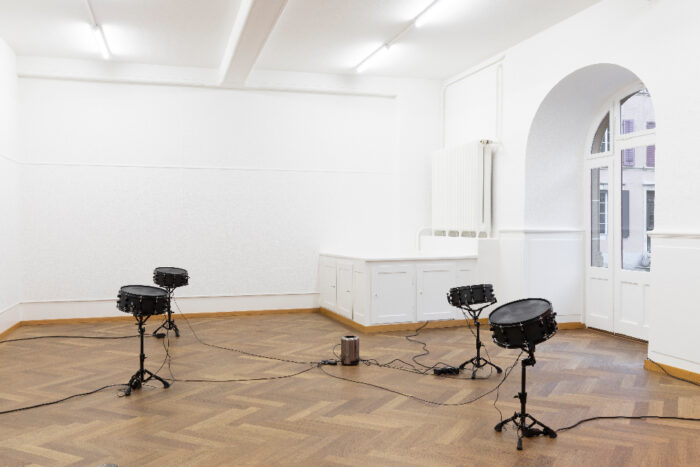
EL: An artistic collaboration is in many ways a tool to resist dominant power structures. It also demonstrates an artist’s ability to willingly lose agency and power. Collaboration, within the art field, is both market-resistant and poses a challenge against the institutional celebration of the single genius mind. I’m a strong advocate of collaboration, but I’m aware that it involves compromise, and ultimately taking a risk creates vulnerability.
MH: Except for two works, each installation is titled with both our names indistinctly. For those who don’t know us, it should be impossible to distinguish who made what. Indeed it would have been so much easier to produce two shows!
JZ: Even with a separation of medium, there is so much we have decided together, all the aspects were determined collaboratively, in terms of how things were made, presented, and contextualised. It has purposefully become hard, even for us, to know who is behind each decision. The deep negotiation process led us to the core of things. By this I mean that it helped me question my own practice in places where I would usually not question it. The other not only forces you to compromise, but their voice helps you to uncover new aspects within your work, and to know yourself better.
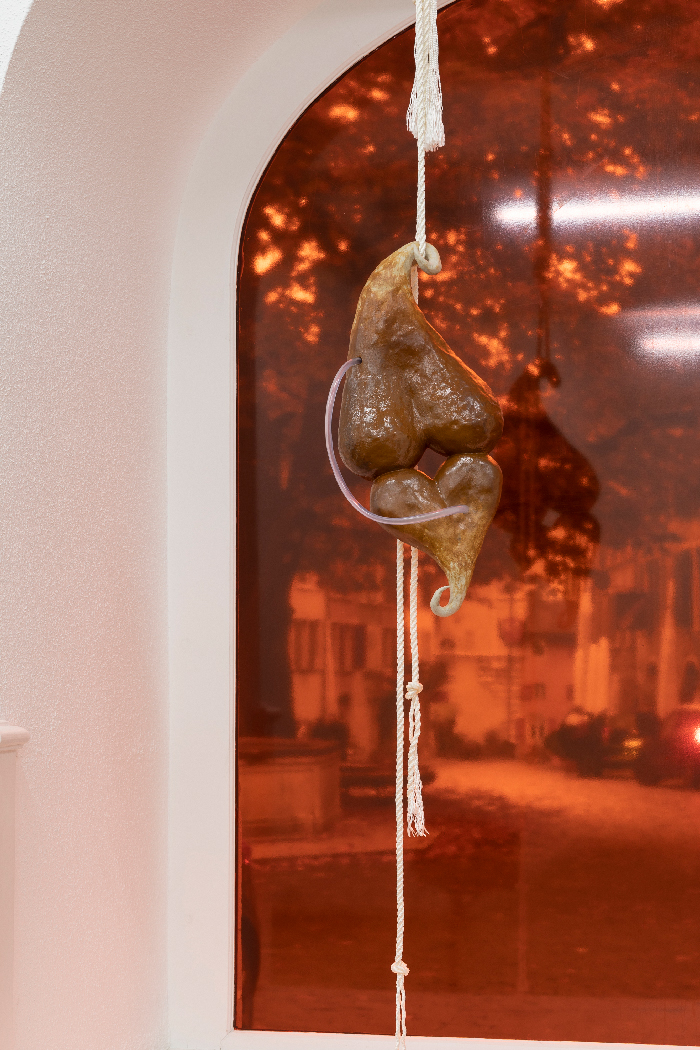
EL: All exhibitions are experiences, but I really enjoyed its various sensory inputs, arranged in order to create a more engaging experience for the viewer. The reference to a grotto is both apparent within the soundscape (sounds of drippings, echoes, etc.) and the aesthetic of the sculptures (that emulate the rough texture of a cave for example). Are we more in an Italian Renaissance garden and its sticky nostalgia towards an idealised nature untouched by mankind or is it Platoon’s cave: where reality can only be experienced through its representation?
MH: In between! The sculptures are indeed like caves. I see them as safe spaces. They may be cute and cosy, but at the same time they symbolise an epicentre, or the dense starting point of a place out of which everything can spill out. I often think of a crystal geode that reveals itself when you crack it open. Something that is precious but hidden, and carries a lot of potential, ready to open up.
JZ: On one hand we have the organic elements; water, ceramic pieces that try to emulate nature; and, on the other hand, we worked with many technical elements, like amplifying boards, speakers, tiny motors, etc. When looking at the guts of the amplifying boards, with tons of cables, knots, etc. it’s hard to know what’s really going on. This complexity informs the experience of the viewer, as much as a piece of clay, a chair, or a table are somehow more self-explanatory. All the elements appear as they are, we never tried to conceal anything. So the natural and “unnatural” do come together very honestly. Their contrasting quality is also what made the exhibition.
MH: Everything comes from the same planet, but with different levels of alienation from mankind, so I don’t really see this dichotomy. I’m really fascinated with all the things we, as humans, do. And everything is influenced by how Nature devises the world, (including those amplifying boards!). I’m fascinated by and attracted to the tech-heavy equipment Julian brought on board, but in my work I’m going in a very different direction: I try to create surfaces that are imperfect, to embrace natural surfaces that are like the skin of my hand and unlike the screen of my phone. My sculptures are like bodies or organs, they’re far from the glossy and perfect finishes of technological devices.




